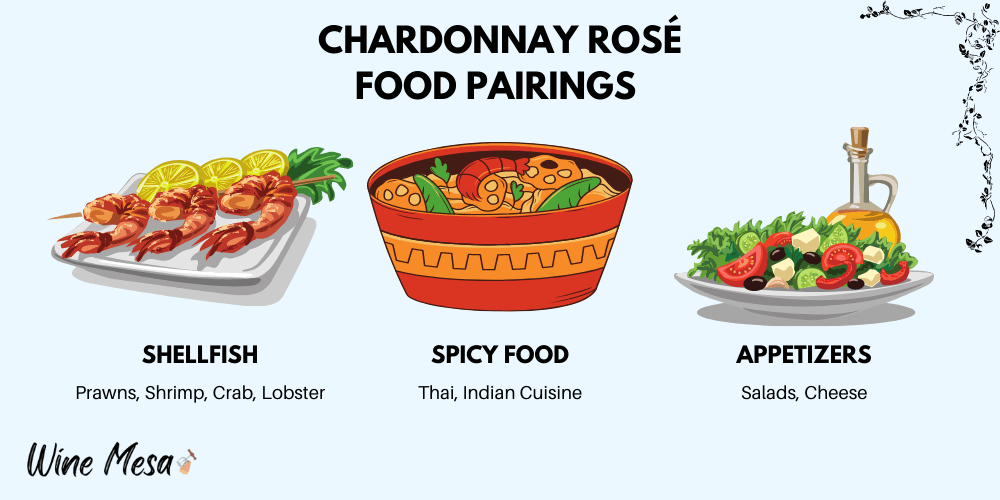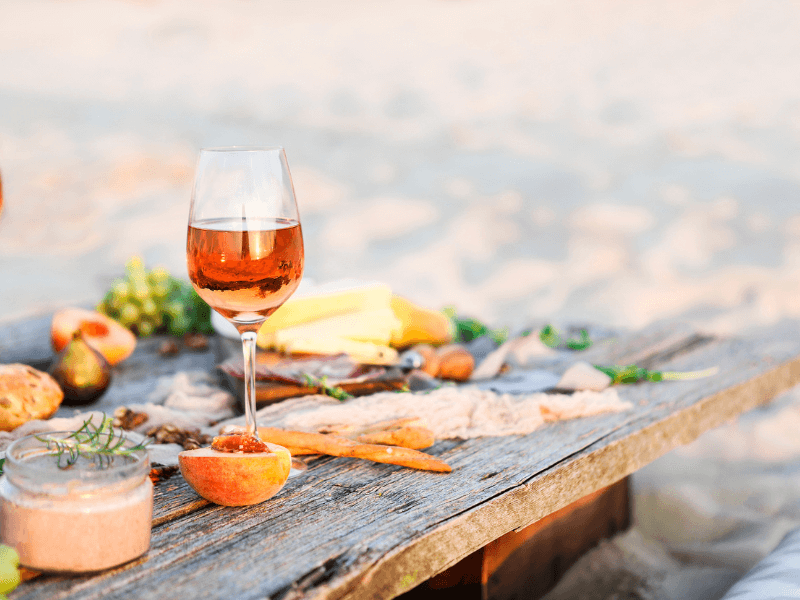If you’re a vino enthusiast, then you probably know a lot about Chardonnay. Chardonnay, after all, is a well-known wine that’s a favorite among individuals from all around the planet. It’s frequently made as a white wine that’s dry.
Many people believe that it’s the globe’s preferred white wine. It’s produced using a grape by the name of Chardonnay.
If you’re keen on this wine that hails from Eastern France’s extremely scenic Burgundy region, then you may want to learn all about its variations. Chardonnay Rosé is the name of a Chardonnay variation that is far from common.
It’s derived from a pink Chardonnay mutation that isn’t known to many people. The wine’s berries, upon ripening, transform into an appealing pink shade.
Are you curious about Chardonnay and all of its thrilling possibilities? You should take the time to learn all about Chardonnay Rosé and the things that it can offer you as a bona fide “oenophile.”

What Does Chardonnay Rosé Taste Like?
People who are crazy about vino often want to know about taste components prior to learning anything else.
This white Chardonnay mutation is an aromatic gem that has a dry feel to it. If you want to revel in a wine-tasting extravaganza that’s the definition of full-bodied and hearty, then this one may get you on the right track.
It’s a wine that is known for its strong concentration. The most common flavor notes found in Chardonnay Rosé are strawberry, citrus, and peach.
People who don’t know this variation often mistakenly think that it may have a classic Rosé flavoring due to its name. That could not be further from the truth. It possesses a timeless and unmistakable white wine taste.
Best Examples of Rosé Chardonnay
Here are the most popular choices for Chardonnay Rosé:
Francis Ford Coppola Winery Sofia Rosé 2020 – This easy-to-drink rosé is ideal for small parties and get-togethers. Serve it chilled along with a cheese platter. It has a gorgeous salmon hue and rich flavors of red berries and peaches.
Hess Select Rosé 2019 – This fantastic bottle opens with a nose of Strawberry and floral scents. It is a dry drink with light citrus and acidity. Expect flavors of strawberry, raspberry, cherry, and citrus. A crisp and elegant wine ideal for sipping.
Bread & Butter Rosé 2020 – A great and easy-to-drink summer wine! Lots of strawberry and red fruit flavors. Ideal to serve during a pool party! Could even be used in a spritzer garnished with grapefruit and berries.
Dark Horse Rosé 2015 – Very impressive for the price. Strawberry, cranberry, boysenberry. Nice floral notes with subtle minerality with crip refreshing acidity. A fantastic option for a mid-week wine with a summer meal outside on the patio or deck.
Jon Josh Irresistibly Cool Pink Chardonnay – Honey, floral notes, and hints of tropical fruit on the nose. Bright straw color with notes of lychee and hints of honey. Crip and smooth finish.
What Food Paris with Rosé Chardonnay?
Few things on the planet can be more enriching and exciting for wine aficionados than finding out about suitable food pairings. If you’re looking forward to relishing a superb Chardonnay Rosé tasting session, then it may help you to find out about all of the mouthwatering foods that work nicely in conjunction with it. Learning about food pairings can contribute to satisfying and memorable meals, too.

Are you a big fan of food that comes from the sea? You can sip your Chardonnay Rosé in the company of seafood that has been grilled. You can sip the wine as you feast on seafood that’s topped in a sauce that’s based on brown butter as well. Salmon that’s roasted may work wonders. The same thing applies to halibut in general.
You can think beyond standard meals, too. Chardonnay Rosé frequently is part of delectable cheese tasting sessions. If you’re enamored by gouda or gruyere that’s aged, then securing some Chardonnay Rosé may be appropriate.
Where Exactly Does This Wine Variation Come From?
If you want to familiarize yourself with this variation, it can help you to first learn a bit about its origins.
Chardonnay Rosé appears practically solely next to Chardonnay, a pleasant village that’s in the southern part of the previously mentioned Burgundy. It often comes specifically from Marsannay, another village.
This genetic mutation was initially observed by an individual by the name of Sylvain Pataille. This was all the way back at the beginning of the new millennium. The man picked up a Blangeys package in 2002 and saw an abundance of shockingly pink grapes during crop gathering.
Mass selection is a technique that has been able to meticulously safeguard this wine’s genetic heritage. Mother plant cutting is a major element of the Chardonnay Rosé realm. This Rosé is exactly the same as its mother plant. The difference simply lies in the previously mentioned berry coloration.
Marsannay isn’t the only “hotspot” for this variation. Macon is yet another tiny village that is thought by many to be a Rosé wellspring at this moment in time.
Understanding Chardonnay Rosé Berries and Cultivation
The bunches of this variation are tiny. They’re packed tightly together as well. Its berries are often little. They’re sometimes moderate in size, too. It always depends.
The flavor of the berries is somewhat straightforward. It isn’t particularly nuanced. These berries help pave the way for wines that are not as acidic as many other Chardonnay options are.
These wines tend to feature additional amounts of sugar as well. The difference in sugar levels, however, is not substantial in the slightest.
The grapes that are a part of this wine attain maturity in the middle of the season. They do upward of three weeks after the Chasselas grapes do so. Their buds burst approximately 24 hours after those of Chasselas grapes.
People who are enthusiastic about this Chardonnay variation occasionally have concerns that relate to pest and disease vulnerability factors, and quite understandably. It’s approximately just as vulnerable to pests and diseases as the other Chardonnay varieties are.
Note, though, that there are certainly some exceptions. The Rosé variation is thought to be a tad less vulnerable to a fungus that’s known simply as grey rot. Grey rot in many cases is associated with damp circumstances.
Production of this specific Chardonnay variety isn’t anything unusual at all. It’s produced in a manner that’s reminiscent of different Chardonnays that are out there. It’s not a stranger to the ins and outs of wild barrel fermentation. It’s not a stranger to lingering inside of barrels prior to release dates, either.
Information about vinification matters can do a lot for people who wish to learn about this Rosé. Vinification, in a nutshell, refers to the transformation of grape juice into the beloved beverage that is known as wine. This transformation as most wine aficionados know is the result of fermentation.
Chardonnay Rosé calls for indigenous yeast alcoholic fermentation. The aging journey lasts for a total of 15 months. It takes place inside barrels that are between the three and four-year range. A small amount of sulfur may be introduced to the vino, but exclusively to bottles.
